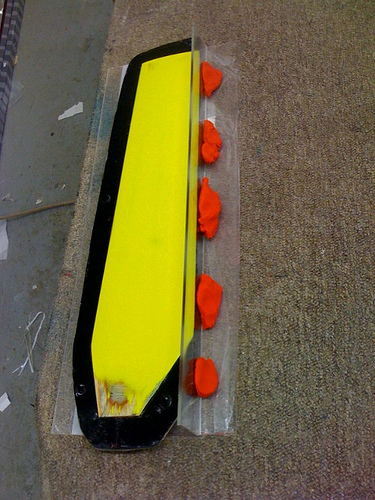This is my method for making foils. I’ve built a mould which can produce one side of a fin or both sides of a rudder.
I will post a pic if my description is too unclear. All the components were srcounged for free.
This will produce a maximum 6mm fin with a camber at whatever distance back from the leading edge is desired.
Materials
-Plank of timber 500x150x30mm, nice and flat for a base
-3 sheets of roofing metal same dimensions, about 1.5mm (cut off scrap by my frindly metal supplies bloke,
still had plastic wrap protection on to keep the surfaces smooth)
-2 straight shims: strips of aluminium 500x10x3mm (cut by the same bloke)
-length of 500x90mm PVC downpipe
-500mm piece of timber - about 3x2 inch.
-2 pieces of ‘release film’ I have been using scraps of mylar sail 510x150mm (5mm overhang at each end, see below) Epoxy will not stick to it and it leaves a glossy surface.
-2 G-clamps
Method
Important: I recommend you have a trial run first and clamp the whole thing together before you start laying up to get the hang of it. Clamp in a newspaper or something.
Glue one piece of sheet metal to timber base to make a very hard base surface. Take the 2 pieces of mylar and trace on the fin outline and mark on the maximum camber (thickness) line - say at 35-40% back from the leading edge, you will need to see this line at both ends to align the clamps on to so rule it fom end to end on the sheet. This is where the 5mm overhang comes in.
Tape one piece of mylar to one of the other two sheets of metal. Place on base and start laying up your CF or glass using the traced pattern as a guide. I used three layers of carbon: one diagonally (which becomes the outside layer), one length of unidirectional and one lengthways (after painting on a generous layer of epoxy first). Excess epoxy carefully spread and wiped out with a credit card. Place second piece of mylar film with fin outline on top aligned with the bottom piece, then last piece of sheet metal on top, trying to keep all the sheets reasonably square and flush with the base.
Now to create the camber.
Gently lift the metal sandwich up and place a shim under each long edge. I had parallel lines marked on the base and the metal sheets (and the mylar sheets) to line the shims up with. They want to be the same distance apart as the maximum width of the fin and keep them parallel.
Place the pipe along the max. camber line, insert the piece of timber inside it and clamp down the timber to the base. The clamp will fit into the mouth of the pipe and onto the timber inside. The pipe is to maintain a gentle curve and the timber is to help keep the pipe straight as you clamp the ends.
The clamps need to be just firm, not so tight that you squeeze all of the epoxy out of the centre. As you tighten you get a feel for how tight is tight enough. The metal sandwich curves in quite a satisfying way. Leave to set. Repeat and make a mirror image - don’t make two the same!
Out will pop a very strong and light sheet with a built in camber. Cut along the template pattern on the mylar and sand the edges straight. Peel off the inside sheets only! Resist the temptation to peel off the outside, leave it on the protect the surfaces for as long as possible. Place two halves together and tape leading edges together. Partly open out from the trailing edge and generously paint in epoxy on both leading and trailing edges, close, wipe and tape trailing edge closed. Rest on leading edge between two books to keep it straight.
Once set, partly tape off small end (leave a small hole for air to escape) and fill with epoxy. I mixed in some fairing filler to lighten it, not too much though, you want the epoxy to be a bit fluid to make it to the other end.
If you take the mylar off too early you can really make a mess of your nice shiny surface. Once set and you’ve sanded the edges to the degree you want - then pull the film off and behold!
For a rudder - both mirror images can be made in the one lay-up.
I’ve made two carbon fins, one carbon rudder and one FG rudder all of which are very strong. The fins, which tapered from about 90mm to 75mm, where about 120gm.
Hope this helps, Tony


